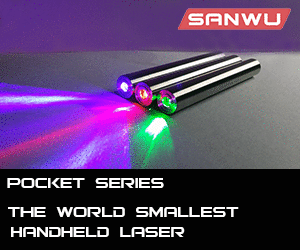- Joined
- Jun 5, 2014
- Messages
- 124
- Points
- 0
How visible is 405nm? Like at 100mw.

Follow along with the video below to see how to install our site as a web app on your home screen.
Note: This feature may not be available in some browsers.



I would imagine it depends on how well you see 405, being so close to the bottom of the spectrum some people see it as violet and some as really dark purple or even gray.
My newly acquired eBay 405nm pens look dark purple to me, tested at 20mw and beam is not visible to me even in pitch black. My under 5mw 532nm looks much brighter.
is 100mw 405 dot dangerous look at without eye protection ?
I'm just going to give you the data and let you work out the math yourself. At 650nm the sensitivity of the human eye is 0.107 of maximum. Peak sensitivity of 1.000 is at 555nm. At 532nm (common green laser pointer) it's 0.862. For 405nm there are conflicting figures. CIE 1931 says 0.00064 while CIE 1978 says 0.004656. I've heard that CIE 1978 works better for young adults in their early-to-mid twenties, while CIE 1931 works better for people in the 40-50 age range. There's also CIE 2006 which has figures for people age 20-80 in ten year increments, but their newer data is proprietary and costs money, so I haven't seen the numbers.
They say children can see 405nm ten times as well as adults, although I haven't seen that confirmed. Many middle-aged adults can't see color in a 405, just gray.
The way the eye works, apparent brightness is not directly proportional to intensity, but to the square root of intensity.
All this applies to the dot, but not necessarily to the beam. When the beam is seen "with smoke" that's the Tyndall effect. It follows the same brightness rules as the dot. "Without smoke" is Rayleigh scattering. The shorter the wavelength the more Rayleigh scattering you get. To calculate how much, divide 1 by the fourth exponent of the wavelength. The Rayleigh scattering with 405nm is 6.635 times as great as at 650nm.
Just off hand, I would agree with others here who say get a 500mW if you really want to see the beam. Just be careful with the dot, since at this wavelength you can't see how bright it really is. That means nothing indoors, and certainly no burning without eye protection. 405nm also presents a blue-light hazard, just basically bad for your eyes.
I know, you just want knock it out for the host, but in case you're wondering.

